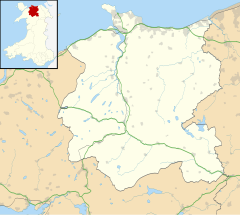Penmachno
| Penmachno | |
|---|---|
 Gethin Square, Penmachno, with the old corner shop |
|
| Penmachno shown within Conwy | |
| OS grid reference | SH790505 |
| Community |
|
| Principal area | |
| Ceremonial county | |
| Country | Wales |
| Sovereign state | United Kingdom |
| Post town | BETWS-Y-COED |
| Postcode district | LL24 |
| Dialling code | 01690 |
| Police | North Wales |
| Fire | North Wales |
| Ambulance | Welsh |
| EU Parliament | Wales |
| UK Parliament | |
| Welsh Assembly | |
Penmachno is a village in the isolated upland valley of Cwm Penmachno, 4 miles south of Betws-y-Coed in the county of Conwy, north Wales. The two parts of the village are linked by a five-arched, stone bridge dating from 1785. The village has been referred to as Pennant Machno, Llandudclyd and Llan dutchyd in historical sources.
According to the 2011 census, the population of the Bro Machno Parish (which also includes Cwm Penmachno) was 617, of whom 342 (55%) were able to speak Welsh and 214 (34%) had no skills in Welsh.
It is renowned as the birthplace of Bishop William Morgan (probably 1545 – 1604), who was born at Tŷ Mawr, Y Wybrnant, near the village; the precise year of his birth is uncertain, it is generally accepted to be 1545, but his memorial in Cambridge suggests 1541.Memorial in St John's College Chapel, Cambridge He was one of the leading scholars of his day, having mastered Hebrew in addition to Latin and Greek. He was the first to translate the Bible in its entirety into Welsh. Tŷ Mawr is now a National Trust property open to the public and contains a Bible museum.
Owen Gethin Jones (1816 - 1883), a building contractor, poet prominent in Eisteddfod circles and local historian, was born on 1 May 1816 at Tyn-y-Cae, Penmachno, and died on 29 January 1883 at Tyddyn Cethin (as recorded in 1871 and 1881 Wales censuses and National Probate Calendar for 1883, but currently known as Tyddyn Gethin (English: Home of Gethin or Gethin House)), also in Penmachno, after being paralysed at the beginning of 1882. He built the Rhiwbach Tramway serving the Blaenau Ffestiniog quarries, the Betws-y-Coed railway station and the Pont-y-Pant railway station, the Pont Gethin viaduct on the Conwy Valley Line spanning the Lledr Valley and St Mary's Church, Betws-y-Coed. His essay on Penmachno, written in the mid 19th century, was first published in 1884 (after his death) in ′Gweithiau Gethin′ (The Works of Gethin). The essay refers to the first nonconformist sermon in the parish in about 1784 at Penrhyn Uchaf; it describes the buildings at Dugoed farm (53°03′11″N 3°46′55″W / 53.053°N 3.782°W) (the oldest part of the farmhouse was built around 1517) and reflects on the possible sites of historical significance on the farm itself including Tomen y Castell as a possible fort and the field Cae'r Braint which means 'Field of Honour' that may have contained a great Bardic circle).
...
Wikipedia

